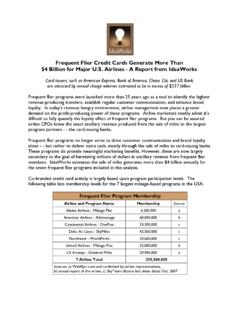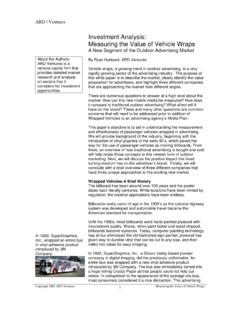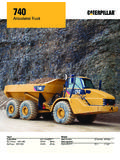Transcription of Chapter IEBGENER: 2 SEQUENTIAL COPY/ …
1 Chapter iebgener : 2 sequential copy /. generate DATA SET. PROGRAM. SYS-ED/. COMPUTER. EDUCATION. TECHNIQUES, INC. JCL Utilities iebgener : Seq copy / generate Data Set Program Objectives You will learn: C Input and output. C iebgener job control statements. C Utility control statements. C generate statement. C MEMBER statement. C RECORD statement. C Printing a SEQUENTIAL data set. C Create a partitioned data set from SEQUENTIAL input. C Convert SEQUENTIAL input into partitioned members. C Copying a data set. C Copying one or more members in a PDS. C Priningt a data set. C Rebooting a data set. C Selecting records to be copied. SYS-ED \COMPUTER EDUCATION TECHNIQUES, INC.
2 (JCL UTIL - ) Ch 2: Page i JCL Utilities iebgener : Seq copy / generate Data Set Program 1 Purpose and Function iebgener is used to: C Create a backup copy of a SEQUENTIAL data set or a member of a partitioned data set or PDSE. C Produce a partitioned data set or PDSE, or a member of a partitioned data set or PDSE, from a SEQUENTIAL data set. C Expand an existing partitioned data set or PDSE by creating partitioned members and merging them into the existing data set. C Produce an edited SEQUENTIAL or partitioned data set or PDSE. C Manipulate data sets containing double-byte character set data. C Print SEQUENTIAL data sets or members of partitioned data sets or PDSEs.
3 C Reblock or change the logical record length of a data set. Input and Output iebgener uses the following input: C An input data set, which contains the data that is to be copied, edited, converted into a partitioned data set or PDSE, or converted into members to be merged into an existing data set. C The input is either a SEQUENTIAL data set or a member of a partitioned data set or PDSE. C A control data set, which contains utility control statements. The control data set is required if editing is to be performed or if the output data set is to be a partitioned data set or PDSE. iebgener produces the following output: C An output data set, which can be either SEQUENTIAL or partitioned.
4 SYS-ED \COMPUTER EDUCATION TECHNIQUES, INC. (JCL UTIL - ) Ch 2: Page 1. JCL Utilities iebgener : Seq copy / generate Data Set Program 2 iebgener Job Control Statements Statement Use JOB Starts the job. EXEC Specifies the program name (PGM= iebgener ) or, if the job control statements reside in a procedure library, the procedure name. SYSPRINT DD Defines a SEQUENTIAL data set for messages. The dataset can be written to a system output device, a tape volume, or a DASD volume. SYSUT1 DD Defines the input data set. It can define a SEQUENTIAL data set or a member of a partitioned data set or PDSE. SYSUT2 DD Defines the output data set. It can define a SEQUENTIAL data set, a member of a partitioned data set or PDSE, or a partitioned data set or PDSE.
5 SYSIN DD Defines the control data set, or specifies DUMMY when the output is SEQUENTIAL and no editing is specified. The control data set normally resides in the input stream; however, it can be defined as a member in a partitioned data set or PDSE. SYSUT1 DD Statement The input data set for iebgener , as specified in SYSUT1, can contain fixed, variable, undefined, or variable spanned records. Concatenated data sets cannot be used with unlike attributes except for block size or device type as input to iebgener . The default record format is undefined (U) for the input data set. Record format must be specified if the data set is new, undefined, or a dummy data set.
6 SYS-ED \COMPUTER EDUCATION TECHNIQUES, INC. (JCL UTIL - ) Ch 2: Page 2. JCL Utilities iebgener : Seq copy / generate Data Set Program SYSUT2 DD Statement The output data set for iebgener , as specified in SYSUT2, can contain fixed, variable, undefined, or variable spanned records (except partitioned data sets or PDSEs, which cannot contain variable spanned records). These records can be reblocked by the specification of a new maximum block length on the SYSUT2 DD. statement. When the data set is on DASD and record format and logical record length are not specified in the JCL. for the output data set, or no data class is assigned to the output data set, values for each are copied from the input data set.
7 The output logical record length must be specified when editing is to be performed and the record format is fixed blocked, variable spanned or variable blocked spanned. Logical record length must also be specified when the data set is new, or a dummy data set, or from a printer. SYS-ED \COMPUTER EDUCATION TECHNIQUES, INC. (JCL UTIL - ) Ch 2: Page 3. JCL Utilities iebgener : Seq copy / generate Data Set Program 3 Utility Control Statements The control statements are included in the control data set as required. If no utility control statements are included in the control data set, the entire input data set is copied sequentially. When the output is to be SEQUENTIAL and editing is to be performed, one generate statement and as many RECORD statements as required are used.
8 If you are providing exit routines, an EXITS statement is required. When the output is to be partitioned, one generate statement, one MEMBER statement per output member, and RECORD statements, as required, are used. If you are providing exit routines, an EXITS. statement is required. A continuation line must start in columns 4 to 16, and a nonblank continuation line in column 72 is optional. Statement Use generate Indicates the number of member names and alias names, record identifiers, literals, and editing information contained in the control data set. EXITS Indicates that user routines are provided. LABELS Specifies user-label processing. MEMBER Specifies the member name and alias of a member of a partitioned data set or PDSE to be created.
9 RECORD Defines a record group to be processed and supplies editing information. SYS-ED \COMPUTER EDUCATION TECHNIQUES, INC. (JCL UTIL - ) Ch 2: Page 4. JCL Utilities iebgener : Seq copy / generate Data Set Program generate Statement The generate statement is required when: C output is to be partitioned. C editing is to be performed. C user routines are provided. C label processing is specified. The generate statement must appear before any other iebgener utility statements. label generate [,MAXNAME=n]. [,MAXFLDS=n]. [,MAXGPS=n]. [,MAXLITS=n]. [,DBCS={YES|NO}]. where: MAXNAME=n Specifies a number, from 1 to 3276, that is greater than or equal to the total number of member names and aliases appearing in subsequent MEMBER statements.
10 MAXNAME is required if there are one or more MEMBER statements. MAXFLDS=n Specifies a number, from 1 to 4095, that is greater than or equal to the total number of FIELD parameters appearing in subsequent RECORD statements. MAXFLDS is required if there are any FIELD. parameters in subsequent RECORD statements. MAXGPS=n Specifies a number, from 1 to 2520, that is greater than or equal to the total number of IDENT or IDENTG parameters appearing in subsequent RECORD statements. MAXGPS is required if there are any IDENT or IDENTG parameters in subsequent RECORD. statements. MAXLITS=n Specifies a number, from 1 to 2730, that is greater than or equal to the total number of characters contained in the FIELD literals of subsequent RECORD statements.



